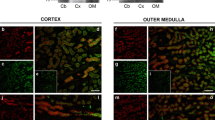Summary
A membrane protein that is immunochemically similar to the red cell anion exchange protein, band 3, has been identified on the basolateral face of the outer medullary collecting duct (MCD) cells in rabbit kidney. In freshly prepared separated rabbit MCD cells, M.L. Zeidel, P. Silva and J.L. Seifter (J. Clin. Invest. 77:1682–1688, 1986) found that Cl−/HCO -3 exchange was inhibited by the stilbene anion exchange inhibitor, DIDS (4,4′-diisothiocyano-2,2′-disulfonic stilbene), with aK 1 similar to that for the red cell. We have measured the binding affinities of a fluorescent stilbene inhibitor, DBDS (4,4′-dibenzamido-2,2′-disulfonic stilbene), to MCD cells in 28.5 mM citrate and have characterized both a high-affinity site (K s1 =93±24 mM) and a lower affinity site (K s2 =430±260 nM), which are closely similar to values for the red cell of 110±51 nM for the high-affinity site and 980±200 nM for the lower affinity site (A.S. Verkman, J.A. Dix & A.K. Solomon,J. Gen. Physiol. 81:421–449, 1983). When Cl− replaces citrate in the buffer, the two sites collapse into a single one withK s1 =1500±400 nM, similar to the singleK s1 =1200±200 nM in the red cell (J.A. Dix, A.S. Verkman & A.K. Solomon,J. Membrane Biol. 89:211–223, 1986). The kinetics of DBDS binding to MCD cells at 0.25 μM−1 are characterized by a fast process, τ=0.14±0.03 sec, similar to τ=0.12±0.03 sec in the red cell. These similarities show that the physical chemical characteristics of stilbene inhibitor binding to MCD cell ‘band 3’ closely resemble those for red cell band 3, which suggests that the molecular structure is highly conserved.
Similar content being viewed by others
References
Bradford, M.M. 1976. A rapid and sensitive method for the quantitation of microgram quantities of protein utilizing the principle of protein-dye binding.Anal. Biochem. 72:248–254
Dix, J.A., Verkman, A.S., Solomon, A.K. 1986. Binding of chloride and a disulfonic stilbene transport inhibitor to red cell band 3.J. Membrane Biol. 89:211–223
Drenckhahn, D., Schluter, K., Allen, D.P., Bennett, V. 1985. Colocalization of band 3 with ankyrin and spectrin at the basal membrane of intercalated cells in the rat kidney.Nature (London) 230:1287–1289
Guidotti, G. 1972. The composition of biological membranes.Arch. Int. Med. 129:194–201
Knauf, P.A. 1979. Erythrocyte anion exchange and the band 3 protein: Transport kinetics and molecular structure.Cur. Top. Membr. Transp. 12:251–363
Koeppen, B.M. 1985. Conductive properties of the rabbit outer medullary collecting duct: Inner stripe.Am. J. Physiol. 248:F500-F506
Kotaki, A., Naoi, M., Yagi, K. 1971. A diaminostilbene dye as a hydrophobic probe for proteins.Biochim. Biophys. Acta 229:547–556
Lepke, S., Fasold, H., Pring, M., Passow, H. 1976. A study of the relationship between inhibition of anion exchange and binding to the red blood cell membrane of 4,4′-diisothiocyano stilbene-2,2′-disulfonic acid (DIDS) and its dihydro derivative (H2DIDS).J. Membrane Biol. 29:147–177
Ramjeesingh, M., Gaarn, A., Rothstein, A. 1980. The location of a disulfonic stilbene binding site in band 3 the anion transport protein of the red blood cell membrane.Biochim. Biophys. Acta 599:127–139
Rao, A., Martin, P., Reithmeier, R.A.F., Cantley, L.C. 1979. Location of the stilbenedisulfonate binding site of the human erythrocyte anion-exchange system by resonance energy transfer.Biochemistry 18:4505–4516
Schuster, V.L., Bonsib, S.M., Jennings, M.L. 1986. Two types of collecting duct mitochondria-rich (intercalated) cells: Lectin and band 3 cytochemistry.Am. J. Physiol. 251:C347-C355
Stone, D.K., Seldin, D.W., Kokko, J.P., Jacobson, H.R. 1983. Anion dependence of rabbit medullary collecting duct acidification.J. Clin. Invest. 71:1505–1508
Talor, Z., Gold, R.M., Yang, W.C., Arruda, J.A.L. 1987. Anion exchanger is present in both luminal and basolateral renal membranes.Eur. J. Biochem. 164:695–702
Verkman, A.S., Dix, J.A., Solomon, A.K. 1983. Anion transport inhibitor binding to band 3 in red blood cell membranes.J. Gen. Physiol. 81:421–449
Zeidel, M.L., Silva, P., Seifter, J.L. 1986a. Intracellular pH regulation and proton transport by rabbit medullary collecting duct cells: Role of plasma membrane H+-ATPase.J. Clin. Invest. 77:113–120
Zeidel, M.L., Silva, P., Seifter, J.L. 1986b. Intracellular pH regulation in rabbit renal medullary collecting duct cells: Role of chloride: bicarbonate exchange.J. Clin. Invest. 77:1682–1688
Author information
Authors and Affiliations
Rights and permissions
About this article
Cite this article
Janoshazi, A., Ojcius, D.M., Kone, B. et al. Relation between the anion exchange protein in kidney medullary collecting duct cells and red cell band 3. J. Membrain Biol. 103, 181–189 (1988). https://doi.org/10.1007/BF01870948
Received:
Revised:
Issue Date:
DOI: https://doi.org/10.1007/BF01870948




